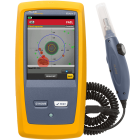Why an MPO Inspection Camera? | An Interview with the Product Manager
March 12, 2019 / General, Installation and testing, Upgrading and troubleshooting, Best Practices
This week, Fluke Networks announced the FI-3000 Fiber Inspector Pro, designed for inspecting the end faces of Multiple Push-On (MPO) fiber connectors. We sat down with Carolyn Carter, the Senior Product Manager for
Why an MPO Inspection Camera?
MPO’s are proliferating both in the data center and outside. Contractors and operators in data centers are struggling to keep up with the explosion of fiber trunks with the ability to support speeds up to 400 Gbps. They’ve been asking for an efficient inspection tool for quite some time now, and we’ve been working with them on this product. But it’s not just the big datacenter folks – MPO’s are showing up everywhere. Fiber to the Antenna for 5G applications will require high bandwidth fiber, a perfect application for MPO’s. They’re also cropping up in multiple dwelling units and even in enterprises, connecting the datacenter to distribution points closer to the end users.
Current solutions, such as our FI-7000, are fine for occasional MPO inspection, but if you’re doing much more than that, it’s just too slow.
Why is MPO inspection important?
Let’s all remember that contamination is the number one cause of fiber failure, so all fiber inspection is essential. With an MPO, you can have parallel channels, so a single speck of dust can take down a trunk carrying hundreds of gigabits per second, possibly affecting hundreds or even thousands of users. Compared to a single fiber, MPO’s have a lot of surface area for contaminants to hang out. When the connector is unplugged and replugged, they can move from a spot where they’re not a problem to one where they are. One big misconception is that pre-terminated fibers come clean from the factory. That’s just not the case, and if you talk with the manufacturers of these trunks they will tell you that you absolutely should inspect them before connecting.
What’s great about this product?
It’s the most efficient way to inspect MPOs. That’s because it gives you the fastest view of the entire endface, and has a user interface that makes it quick and easy to zoom into areas of concern.
How fast?
You’ll get a view of the entire endface in the time it takes to autofocus the image – no more than two seconds. Then you can use simple gestures to move from a view of the entire endface to individual fibers – we call it “Live View”, and it’s unique to the FI-3000.
Why is seeing the whole endface important?
As I noted above, there’s a lot of endface area where contaminants can hide. So it’s important to look it all over, as well a look at the individual endfaces.
How does it do that?
There are multiple cameras in the FI-3000, and we stitch the multiple images together in real time forming a single view. The processing is so fast and seamless that it just looks like a single camera.
Can it automatically pass or fail an MPO?
Yes, it tests to the IEC-61300-3-5 standards for one and two-row connectors with 12 or 16 fibers per row and provides a Pass or Fail results showing which fibers passed and which failed. This takes less than two seconds per fiber. You can generate a report with a summary view or a full report with an image of each endface.
What customers love about that is that they don’t have to waste time waiting for an automated inspection result that is going to fail. Most of the time, the Live View will let you know if the endface is likely to pass or needs cleaning. Then you can document it knowing it is likely to pass, or clean it as needed and use Live View again.
The FI-3000 looks different than any other camera or product we make. Why is that?
We wanted to make it comfortable to hold, and get into tight spaces, so that drove the design. We put the buttons on the back so you could keep your other hand free. It also fits very nicely into the included holster which makes it easy to keep with you as you look for MPO’s to inspect. And of course, we wanted to make it rugged, and the compact design makes that easier to do.
How is the user interface different?
Everybody has a smartphone today, so they expect state-of-the-art in usability. We used all the latest gesture-based user interface building blocks in the FI-IN application which works on Android or Apple phones. So customers just pick it up and start panning around the image, zooming in and out without any instructions at all. It’s not unlike what we’ve done with other Versiv models, such as the OptiFiber Pro OTDR.
Speaking of Versiv, will it work with the FI-3000?
Yes, but not until the second half of the year. We’re fully integrating it into the Versiv family, so you’ll be able to operate it from your existing tester and use LinkWare to manage all your test results: copper, fiber loss, OTDR and inspection. If you purchase the FI-3000 today, you’ll be able to use it with your phone for now, and then with both the phone and Versiv when the new Versiv code is released.
Any last words?
It’s all very interesting to hear about this product, but if you’re interested you need to get a demonstration. You can do that by visiting this page: https://www.flukenetworks.com/contact_sales. When I explain the FI-3000 to customers, they get interested, but when they pick it up and use it, the light really goes on for them.







